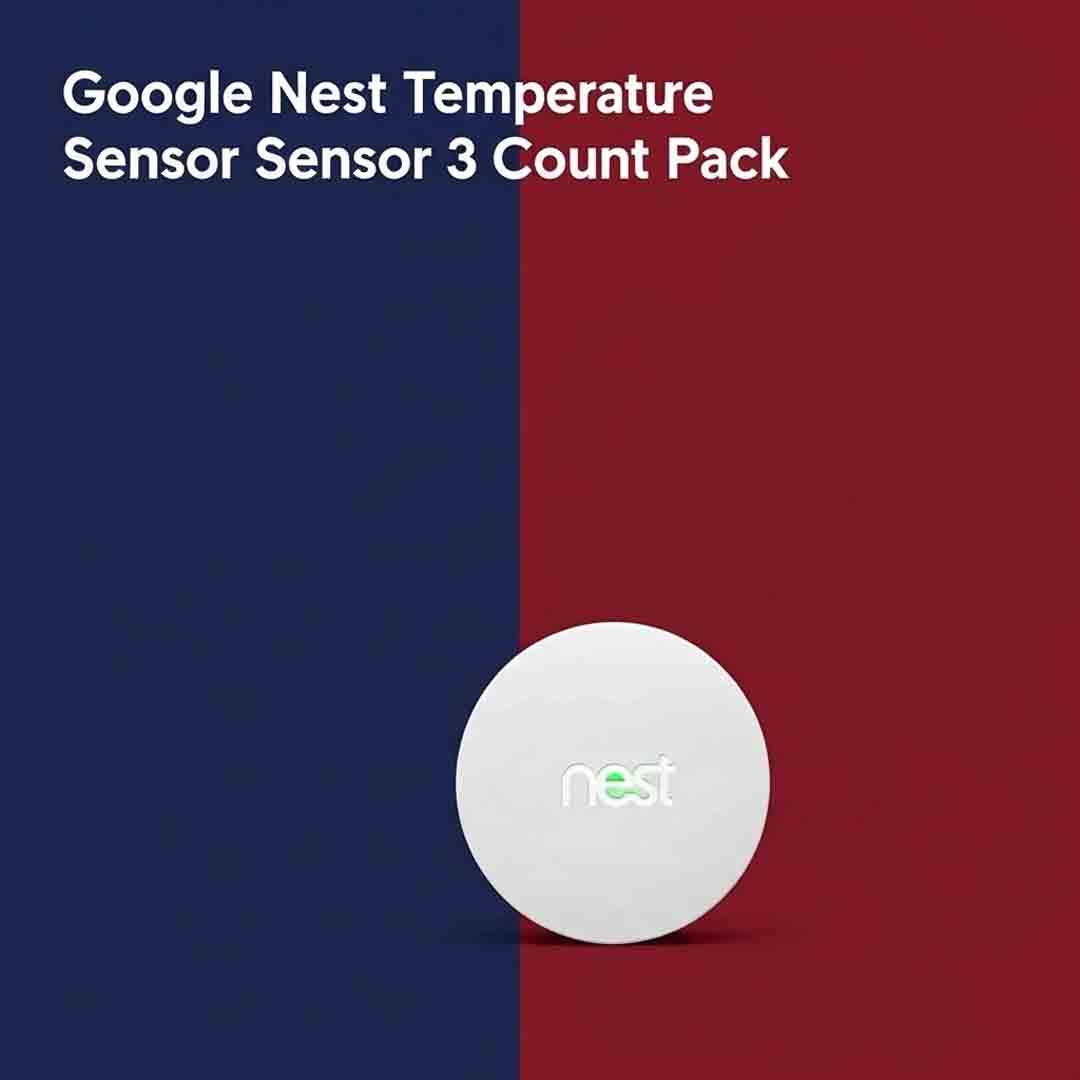The Google Nest Temperature Sensor (3-pack) is a collection of cordless climate detectors built to function seamlessly with supported Nest thermostats like the Nest Learning Thermostat (3rd or 4th generation) and Nest Thermostat E. Unlike the thermostat’s integrated sensor, each of these satellite units can be positioned in frequently used spaces (such as bedrooms or living rooms), ensuring heating or cooling is adjusted to where comfort is most important.
Setup is simple: once the sensor is added to your Google Home or Nest app profile, you position it at about chest level (to avoid distorted readings from hot air near the ceiling or cool drafts near the floor) and within Bluetooth reach of the thermostat (up to around 50 feet, though walls or obstacles may shorten this). The unit runs on a CR2 lithium battery and typically lasts up to three years before replacement is needed. After installation, you can program which sensor your thermostat should follow at different times, or even combine readings from several sensors to optimize system performance.
The advantage of the Nest sensors lies in maintaining more even comfort levels and potentially enhancing HVAC efficiency. For homes where heating and cooling are inconsistent (for instance, bedrooms running too warm upstairs or distant areas lagging behind the thermostat), these sensors help smooth out those imbalances by giving the system a clearer picture of the room’s true climate. Still, some users consider the added expense disproportionate to the functionality offered. As one review noted: “A 3-pack ought to be $50 for what little they provide.” Whether or not the purchase makes sense depends on the temperature discrepancies in your house and the importance you place on precision control.

Specifications
Here are the key specifications and technical details for the Google Nest Temperature Sensor (as commonly sold — note that a 3-pack just bundles three units with the same specs):
Technical Specifications
- Dimensions: ~ 1.9 in (diameter) × 0.8 in (height) (≈ 50 mm × 22 mm)
- Weight: ~ 1.6 oz (≈ 45 g)
- Operating (Ambient) Temperature Range: 32 °F to 104 °F (0 °C to 40 °C) (indoor use only)
- Power / Battery: One CR2 3 V lithium battery (included); typical battery life up to 2 years under normal use
- Wireless / Connectivity: Bluetooth Low Energy (BLE), with effective communication range up to about 50 ft (≈ 15 m) in perfect conditions (walls, obstacles, interference can reduce this)
- Accuracy: Measurement accuracy of approximately ±1.5% (for the temperature range)
Compatibility & Functional Limits
- Compatible Thermostats: Nest Learning Thermostat (3rd & 4th generation) and Nest Thermostat E
- Sensor Support / Limits: You can connect as many as six sensors to one supported Nest thermostat. In houses with multiple thermostats (separate “zones”), as many as 18 sensors can be installed altogether.
- Scheduling / Control: Through the Google Home or Nest app, you can set a timetable for which sensor the thermostat relies on at various times of day.
- Other Limits / Notes:
• The sensor tracks temperature alone (it does not detect humidity or movement).
• If the sensor stops transmitting (for example, due to dead battery or being out of range), the thermostat will revert to its internal sensor.
• Made for indoor applications only and not certified for outdoor or rugged exposure.
• The battery compartment can be opened (for instance, by twisting) to swap the cell, and the app will notify you when the battery is low.

Key Features
Here are some key features of the Google Nest Temperature Sensor (3-pack):
- Remote temperature sensing & control
The sensor lets you position temperature checkpoints in frequently used rooms instead of depending only on the thermostat’s integrated sensor. The thermostat can be set to follow that sensor’s reading rather than its own when you choose. You may also schedule which sensor—or room—directs the thermostat at various times of the day. - Wireless & long battery life
Each sensor pairs with the Nest thermostat using Bluetooth Low Energy (BLE), offering an effective range of about 50 feet (≈15 m) in open conditions, though barriers like walls may shorten it. Powered by a CR2 3V lithium battery (included), the sensor generally lasts up to 2 years—or as long as 3 years in newer models—with regular use. - Multi-sensor support & flexible scheduling
Each Nest thermostat supports a maximum of six linked sensors. This setup gives you options: you can schedule control from a preferred sensor or merge readings from multiple sensors. The newer generation introduces the ability to smooth out comfort levels by averaging inputs from more than one sensor.

How to use the Google Nest Temperature Sensor 3 Count Pack
Here’s a clear guide on how to use the Google Nest Temperature Sensor (3-pack) with your compatible Nest thermostat:
1. Set up and pair the sensor
- Open the Google Home app (or Nest app if still supported in your region).
- In the app, go to Add > Set up device > Nest Temperature Sensor.
- Proceed with the guided steps to capture the QR code from the rear of the sensor or input the pairing code manually.
- The app will notify you once the sensor successfully links to your thermostat.
2. Place the sensor in the right location
- Select the space where you’d like more precise temperature control (e.g., bedroom, nursery, lounge).
- Place the sensor around chest level on a table, shelf, or wall—keep it away from floors, ceilings, or vents.
- Keep the device within BLE reach, typically up to 50 feet in open areas, but reduced when obstructions are present.
- Keep it away from direct sun, drafts, or nearby heat/cooling sources that may distort the temperature reading.
3. Control how the thermostat uses it
- In the app, go to your thermostat > Settings > Sensors.
- Select the sensor to control the thermostat immediately, or set up a timetable (e.g., bedroom at night, living room by day).
- If you’re using more than one sensor, you can combine their readings to create an average for steadier comfort.
- The thermostat will regulate heating or cooling automatically according to the temperature reported by the active sensor.
Tips suitable for the Google Nest Temperature Sensor 3 Count Pack
Here are some practical tips for getting the best performance out of your Google Nest Temperature Sensor (3-pack):
Placement Tips
- Keep it at chest height: It delivers a more realistic sense of comfort, reflecting what occupants feel rather than the heat rising overhead or the chill near the ground.
- Avoid drafts and heat sources: Avoid positioning the sensor close to vents, heaters, radiators, windows, or direct sun, as this may produce inaccurate readings.
- Choose high-use rooms: Place sensors in the rooms where comfort is most important, like the bedroom at night or the living room during daytime hours.
Usage & Scheduling Tips
- Create a daily schedule: Through the app, direct your thermostat to follow the bedroom sensor for nighttime hours and the living room sensor during the daytime. This maintains comfort and energy savings.
- Use averaging (if supported): If you’re running more than one sensor, you can turn on averaging so the thermostat evens out temperature swings across the house.
- Test and adjust: Test various sensor positions for a few days. If a room doesn’t feel right, shift the device slightly until you discover the ideal spot.
Maintenance Tips
- Check battery life: Each sensor is powered by a CR2 battery, usually lasting 2–3 years. The app will notify you when it’s low, so replace it quickly.
- Stay in range: If the sensor frequently loses connection, try placing it nearer to the thermostat or adjusting its position to strengthen Bluetooth reception.
- Clean gently: Clean the outside with a gentle, dry cloth to keep dust from impacting operation. Do not use liquids or sprays.

Cleaning guide
Here’s how to safely clean your Google Nest Temperature Sensor without damaging it:
Step-by-Step Cleaning
- Turn off your HVAC system (optional but recommended): This prevents the thermostat from reacting to changing readings while you move or adjust the sensor.
- Remove the sensor from its spot: Carefully lift it from the shelf, wall, or tabletop.
- Wipe the exterior: Wipe with a soft, dry microfiber cloth to clear dust and fingerprints. This is generally sufficient for routine upkeep.
- For stubborn dirt: Moisten the cloth lightly with water (do not saturate). Wipe gently and dry right away with a clean, dry cloth.
- Check the battery cover: If dust accumulates around the battery cover, clean gently. Only open the cover when changing the battery.
Important Don’ts
- Avoid strong cleaning agents such as bleach, ammonia, or alcohol, as they may harm the casing.
- Avoid abrasive materials like scouring pads or paper towels, as they can scratch the surface.
- Avoid submerging the sensor in water or spraying liquids directly on it.
Light dust removal occasionally is all that’s needed to keep the sensor functioning well.
What to avoid when using the Google Nest Temperature Sensor 3 Count Pack
Here are the main things you should avoid when using the Google Nest Temperature Sensor (3-pack):
Placement & Environment
- Keep the sensor away from direct sun or heat sources like lamps, radiators, or heaters, as they may produce inaccurate high readings.
- Keep the sensor away from vents, fans, or drafty windows, as airflow can distort temperature readings.
- Do not place the sensor outdoors or in moist locations—it’s designed for indoor use only and not built to withstand weather.
- Keep the sensor out of corners or behind furniture, as restricted airflow may affect measurement accuracy.
Handling & Maintenance
- Avoid dropping, hitting, or pressing the sensor forcefully—its delicate casing and electronics may be damaged.
- Avoid opening the sensor unnecessarily—only access the battery cover when changing the CR2 battery.
- Do not use strong chemicals, scrubbing pads, or submerge in water—simply wipe with a dry or lightly damp microfiber cloth.
- Do not overlook low-battery alerts; a depleted sensor won’t report temperature, so the thermostat defaults to its built-in sensor.
Connectivity & Use
- Do not place the sensor too far away; its Bluetooth range is roughly 50 ft under ideal conditions, less if blocked by walls or devices.
- Do not exceed the sensor limit for a single thermostat—it supports up to 6 sensors, and adding more may cause setup issues.
- Don’t anticipate additional functions—the Nest Sensor provides temperature data only, not humidity or occupancy sensing.
In conclusion, the Google Nest Temperature Sensor (3-pack) is a convenient add-on for Nest thermostats that improves comfort by measuring temperatures in the rooms that matter most. It’s easy to install, battery-powered, and works wirelessly, making it simple to manage multiple rooms. While it only measures temperature (not humidity or motion), it’s ideal for fixing hot and cold spots and gives you more precise, room-by-room control of your home’s climate.


Write a Comment